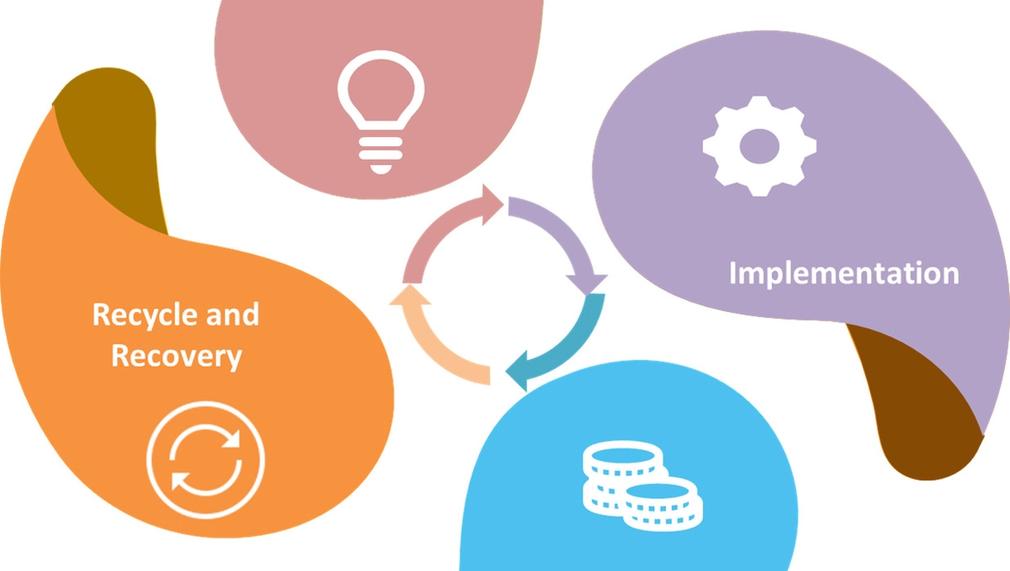LA Industry: Circular Textiles
LA Industry aims to create a centralized HUB where material byproducts from businesses can be repurposed instead of going to landfills. This HUB will create a local closed-loop market that promotes a circular economy by providing stable and consistent material streams for reuse. Two key success factors that will be addressed are the management of an online material exchange platform and quality control/assurance.

Has your proposal changed due to COVID-19?
Amid the current COVID-19 situation, our team wants to add an innovative challenge for upcycling enthusiasts to design reusable PPE with textile scrap. This would create a win-win situation in both protecting the environment by reducing the amount of waste going to landfills and supporting our frontline workers.
Safety is our number one priority when creating the centralized HUB. Proper precautions, worker protections, and all LA County Public Health guidelines will be enforced. The scale and timeline of the planned project are flexible and will be adjusted accordingly.
In which areas of Los Angeles will you be directly working?
County of Los Angeles
City of Los Angeles
In what stage of innovation is this project?
Pilot project or new program
What is the need you’re responding to?
Under Mayor Eric Garcetti, the City of LA created L.A.’s Green New Deal sustainability pLAn. The pLAn has ambitious goals of reaching zero waste by 2050. This can only be achieved by moving towards a circular economy through the implementation of different tools. As a municipality and sustainable business assistance team working directly with LA’s manufacturers and businesses, LA Industry is uniquely qualified to foster connections and build infrastructure to support this project. The design and implementation of a centralized HUB and online access portal to manage exchanges and quality control of the inventory will be one of the pollution prevention and sustainability strategies used to help businesses and industries reduce costs and environmental footprints. Our clients voiced concerns about a lack of local opportunities to reuse, repurpose, or recycle material streams along with L.A.’s Green New Deal’s prestigious zero waste goals provided a perfect opportunity for this project.
Why is this project important to the work of your organization?
As the City of LA, LA Sanitation and Environment’s pollution prevention and sustainability team, LA Industry shares common underlying goals of protecting public health and the environment as well as our own goals of aiding economic development and business continuity in the LA Region. We are constantly exploring new strategies and opportunities with a collaborative network of internal and external partners to cultivate a business-friendly environment for businesses and industries to thrive while meeting regulatory compliance. All the goals in L.A.’s Green New Deal are delegated to their respective agencies. As a part of LA Sanitation and Environment, LA Industry is in a unique position to tackle these zero waste goals through the creation of a centralized HUB and an online exchange portal given our team’s goals of aiding economic development, business continuity, and our direct connection to businesses and industries.
Approximately how many people will be impacted by this proposal?
Direct Impact: 70,000
Indirect Impact: 4,000,000
Please describe the broader impact of your proposal.
The creation of a centralized HUB has infinite impact potential. The HUB as proposed is focused on post-industrial material streams and will create new markets, green jobs, and economic opportunities for entrepreneurs to find innovative solutions to reuse, repurpose, and recycle. This HUB will be a centralized location where businesses and organizations can browse clean material streams to use as feedstock in their manufacturing processes, reducing the amount of virgin materials used and thus creating cost savings. A successful HUB will be an important tool to aid the City of LA in reaching 100% landfill diversion by 2050 as well as being a proven model other cities moving towards sustainability can implement.
Please explain how you will define and measure success for your project.
On a shorter timeline, this grant will allow us to set up a centralized HUB where businesses and organizations can store clean textile scraps sorted by color and content that would otherwise end up in landfills. These repurposed scraps will naturally create new markets, business partnerships, and green jobs in both the creative and manufacturing sectors as innovative reuse and repurposing methods are employed.
On a longer timeline, as the HUB gains more users, an online exchange portal will be implemented to expand the reach and streamline the efficiency of these transactions. Due to the immense volume of the City of LA's textile and garment waste, our project will target the collection and repurposing of post-industrial textile scraps. Diverting this textile waste would support L.A.’s Green New Deal’s waste goals of 100% organic waste diversion by 2028, 100% landfill diversion by 2050, and 50% local material reuse by 2035. We hope to achieve a successful, circular, and streamlined business model for textiles that can be applied to other material streams. This includes mapping out the A’s (material stream producers), B’s (intermediate processors), C’s (end users), as well as monitoring transactions to establish a dashboard of tracking metrics (ie: frequency, tonnage, composition, active users, cost savings, value creation, etc.)
Which of the CREATE metrics will your submission impact?
Manufacturing activity
Employment in the creative industries
Jobs per capita
Which of LA2050’s resources will be of the most value to you?
Access to the LA2050 community
Host public events or gatherings
Capacity, including staff
Strategy assistance and implementation